Adding rocks to your landscape is an excellent way to enhance curb appeal, improve drainage, and reduce maintenance, and at rockscapes.net, we’re here to show you how! Whether you’re aiming for a rustic, natural look or a modern, minimalist design, integrating stones into your outdoor space can create a stunning and durable landscape. Our guide will cover various design ideas, rock types, and installation tips. Discover unique rock placement ideas and turn your yard into an eye-catching masterpiece by creating rock gardens and xeriscapes with help from rockscapes.net.
1. Why Use Rocks in Your Landscape?
Why should you consider adding rocks to your landscape? Landscaping with rocks provides numerous advantages, making it a popular choice for homeowners looking to enhance their outdoor spaces.
- Enhanced Curb Appeal: Rocks introduce texture, color, and visual interest, significantly boosting your home’s curb appeal.
- Improved Drainage: Rocks facilitate better water drainage compared to soil, preventing puddles and potential water damage.
- Low Maintenance: Unlike grass and many plants, rocks require minimal upkeep, saving you time and resources.
- Erosion Control: Rocks can effectively stabilize soil and prevent erosion, particularly on slopes or in areas prone to runoff.
- Weed Suppression: When used as mulch, rocks can suppress weed growth, reducing the need for herbicides.
- Eco-Friendly Option: Using locally sourced rocks supports sustainable landscaping practices and reduces the carbon footprint associated with transporting materials over long distances.
- Versatility: Rocks can be used in various landscaping applications, from decorative accents to functional elements like retaining walls and walkways.
- Year-Round Interest: Rocks provide visual interest throughout the year, even in winter when plants are dormant.
- Drought Tolerance: Rock landscapes are drought-tolerant and can thrive in arid climates, conserving water and reducing irrigation needs.
- Natural Look: Rocks blend seamlessly into natural settings, creating a harmonious and organic landscape design.
2. Understanding Your Landscape’s Style
How do you match rocks to your landscape’s style? Integrating rocks effectively requires careful consideration of your existing landscape style.
- Formal Gardens: For formal gardens, opt for symmetrical arrangements and precisely placed rocks. Smooth, rounded stones or neatly stacked flagstones can complement the structured aesthetic.
- Informal Gardens: Informal gardens thrive on naturalism. Use a variety of rock sizes, shapes, and textures to mimic a natural environment. Scatter rocks seemingly at random for an organic look.
- Modern Landscapes: Modern landscapes benefit from clean lines and minimalist designs. Large, angular boulders or uniform gravel can add a contemporary touch.
- Rustic Settings: In rustic settings, choose rough-hewn, weathered rocks that blend with the natural surroundings. River rocks and moss-covered stones enhance the rustic charm.
- Xeriscapes: Xeriscapes focus on drought-tolerant plants and rocks. Use gravel, boulders, and other rock types to create a water-wise landscape that thrives in arid conditions. Arizona State University’s School of Earth and Space Exploration research confirms that xeriscaping can reduce water consumption by up to 60% in desert climates.
- Japanese Gardens: Japanese gardens emphasize balance and harmony. Incorporate carefully selected rocks, such as granite or moss-covered stones, to create serene and contemplative spaces.
- Coastal Gardens: Coastal gardens can feature rocks that complement the beachy vibe. Use smooth, light-colored stones and shells to evoke the seaside environment.
- Woodland Gardens: Woodland gardens benefit from the addition of rocks that mimic a forest floor. Use moss-covered stones and natural rock formations to enhance the woodsy feel.
3. Types of Rocks for Landscaping
What are the best rock options for your landscaping project? Selecting the right type of rock is crucial for achieving the desired look and functionality in your landscape.
- River Rock: Smooth, rounded stones that are ideal for dry creek beds, water features, and pathways. They come in various sizes and colors.
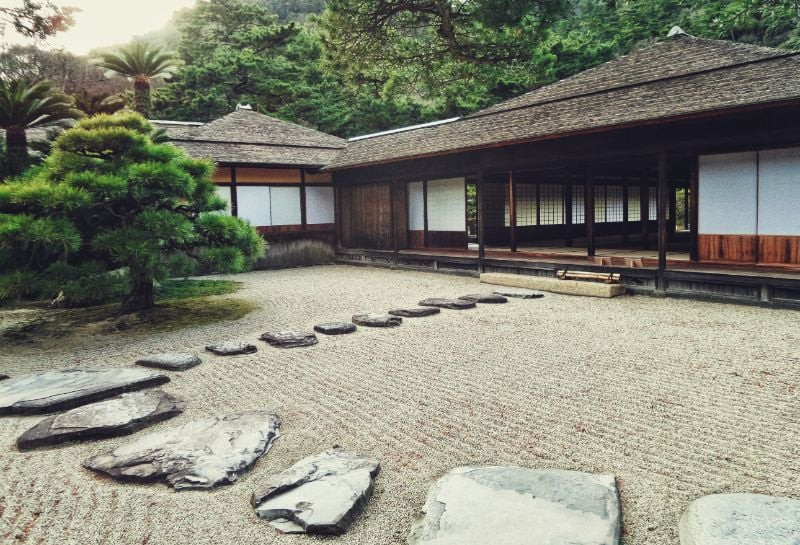 River Rock Pathway
River Rock Pathway
Alt text: A stepping stone pathway is made of smooth river rocks laid out across a lush green garden to guide pedestrians.
- Gravel: Small, crushed rocks that are perfect for pathways, driveways, and as a mulch alternative. Available in different colors and textures, gravel provides excellent drainage.
- Boulders: Large, individual rocks that can serve as focal points, retaining walls, or natural seating. Boulders add drama and structure to any landscape.
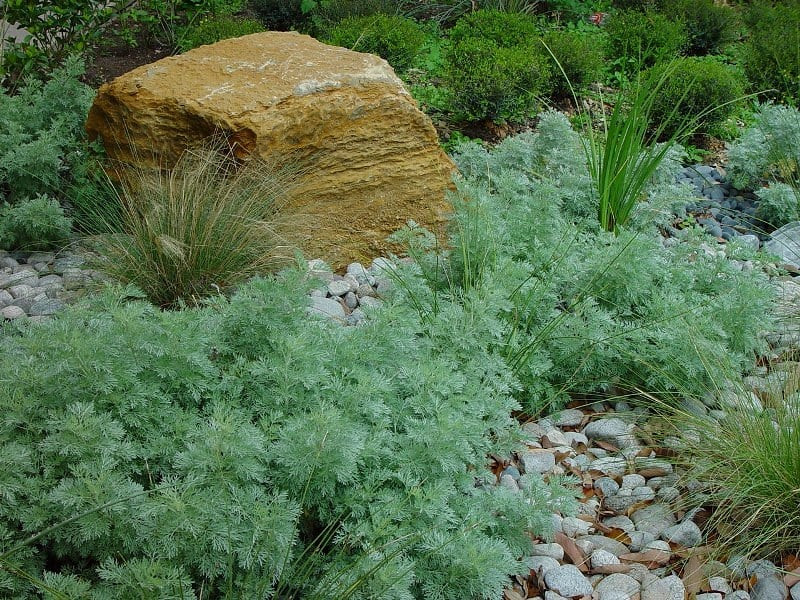 Large Rock in garden bed
Large Rock in garden bed
Alt text: A large rock is placed in the middle of a garden bed to add a dramatic visual appeal to the landscape design.
- Flagstone: Flat, sedimentary rocks used for patios, walkways, and stepping stones. Flagstone offers a natural, rustic look with its irregular shapes and textures.
- Lava Rock: Porous, lightweight rocks that are excellent for fire pits, garden beds, and drainage. Lava rock retains moisture and adds a unique volcanic texture to the landscape.
- Decomposed Granite: Fine, granular rock material used for pathways, driveways, and erosion control. Decomposed granite is easy to compact and provides a natural, stable surface.
- Cobblestone: Rounded or square-cut stones used for paving driveways, pathways, and edging. Cobblestone adds a historic, charming touch to any landscape.
- Pea Gravel: Small, rounded gravel that is comfortable to walk on and ideal for playgrounds, pathways, and garden beds. Pea gravel comes in various colors and is an affordable landscaping option.
- Slate: Thin, flat rocks used for pathways, patios, and vertical accents. Slate adds a sleek, modern touch to the landscape with its smooth texture and dark color.
- Quartzite: Hard, durable rock that is resistant to weathering and ideal for high-traffic areas like driveways and walkways. Quartzite comes in various colors and provides a sparkling, elegant look.
- Fieldstone: Naturally occurring rocks collected from fields, used for walls, borders, and accents. Fieldstone adds a rustic, natural touch to any landscape.
4. Planning Your Rock Landscape Design
How can you plan a rock landscape effectively? Effective planning is essential for a successful rock landscape design.
- Assess Your Space: Evaluate the size, shape, and topography of your yard. Identify areas that would benefit from rock features.
- Consider Drainage: Determine how water flows through your property and use rocks to improve drainage and prevent erosion.
- Sketch a Design: Create a rough sketch of your desired rock landscape. Experiment with different layouts and rock types.
- Choose a Focal Point: Select a central feature, such as a large boulder, water feature, or rock garden, to anchor your design.
- Incorporate Plants: Combine rocks with drought-tolerant plants to create a balanced and visually appealing landscape.
- Plan for Pathways: Designate pathways using gravel, flagstone, or stepping stones to provide access and guide movement through the landscape.
- Consider Functionality: Think about how you will use the space and incorporate functional elements like seating areas, fire pits, or retaining walls.
- Budget Accordingly: Estimate the cost of materials and labor and adjust your design to fit your budget.
- Obtain Permits: Check local regulations and obtain any necessary permits before starting your project.
- Consult Professionals: If you’re unsure about any aspect of the design or installation, consult with a landscape designer or contractor for expert advice.
5. Preparing the Area for Rock Installation
What steps are necessary to prepare your landscape for rocks? Proper preparation ensures the longevity and stability of your rock landscape.
- Clear the Area: Remove grass, weeds, and debris from the area where you will be installing rocks.
- Grade the Soil: Level the soil to create a smooth and even surface. Slope the ground slightly to promote drainage.
- Install Landscape Fabric: Lay down a layer of landscape fabric to prevent weed growth and keep rocks from sinking into the soil.
- Edge the Area: Install edging materials, such as plastic, metal, or stone, to contain the rocks and define the boundaries of the landscape.
- Compact the Soil: Use a soil compactor to firm up the soil and create a stable base for the rocks.
- Amend the Soil: If you plan to incorporate plants, amend the soil with compost or other organic matter to improve its fertility and drainage.
- Install Irrigation: If necessary, install an irrigation system to provide water to plants in the rock landscape.
- Consider Drainage: Ensure proper drainage by installing French drains or other drainage solutions to prevent water buildup.
- Protect Existing Plants: Protect existing trees and shrubs from damage during the installation process.
- Plan for Access: Plan for easy access to the area for equipment and materials during the installation process.
6. Adding Rocks to Garden Beds
How do you integrate rocks into your garden beds? Adding rocks to garden beds can enhance their visual appeal and functionality.
- Rock Mulch: Replace traditional mulch with rocks to retain moisture, suppress weeds, and add texture to the garden bed.
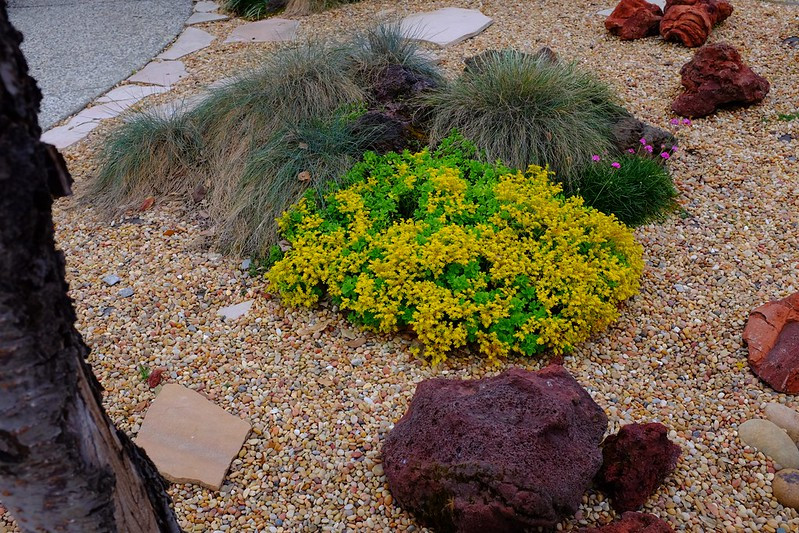 Rock Mulch Garen Bed
Rock Mulch Garen Bed
Alt text: A garden bed is covered in rock mulch to retain moisture, suppress weeds, and add texture.
- Accent Rocks: Place strategically sized rocks around plants to highlight their beauty and create visual interest.
- Rock Borders: Use rocks to define the edges of the garden bed and create a clean, polished look.
- Elevated Beds: Create raised garden beds with rock walls to add dimension and improve drainage.
- Rock Gardens: Design a rock garden with alpine plants and various rock formations to mimic a mountain landscape.
- Dry Creek Beds: Incorporate a dry creek bed into the garden bed to improve drainage and add a natural element.
- Water Features: Add a small water feature with rocks to create a soothing and visually appealing focal point in the garden bed.
- Color Coordination: Choose rocks that complement the colors of the plants and flowers in the garden bed.
- Texture Contrast: Combine rocks with different textures to create visual interest and depth in the garden bed.
- Vertical Accents: Use tall, upright rocks to add vertical accents and create a sense of height in the garden bed.
7. Constructing Rock Pathways and Walkways
What are the best practices for rock pathways and walkways? Rock pathways and walkways add charm and functionality to your landscape.
- Flagstone Pathways: Create a natural, rustic pathway with flat flagstones placed in a stepping-stone pattern.
- Gravel Walkways: Design a comfortable and affordable walkway with compacted gravel in a variety of colors.
- River Rock Pathways: Construct a pathway with smooth river rocks for a natural, water-worn look.
- Cobblestone Walkways: Build a charming, historic walkway with rounded or square-cut cobblestones.
- Decomposed Granite Pathways: Create a stable, non-slip pathway with compacted decomposed granite.
- Stepping Stone Pathways: Use large, flat rocks as stepping stones to create a whimsical and practical pathway.
 River Rock Pathway
River Rock Pathway
Alt text: A stepping stone pathway is made of smooth rocks laid out across a lush green garden.
- Bordered Pathways: Define the edges of the pathway with larger rocks to create a clear boundary.
- Curving Pathways: Design a winding pathway to add visual interest and encourage exploration of the landscape.
- Accessibility: Ensure the pathway is wide enough and has a stable surface for easy access.
- Drainage: Provide proper drainage to prevent water buildup and ensure the pathway remains safe and usable.
8. Creating Rock Water Features
How can you build stunning water features with rocks? Rock water features add tranquility and beauty to any landscape.
- Ponds: Line a pond with rocks and add aquatic plants to create a natural, serene water feature.
- Waterfalls: Construct a waterfall with stacked rocks to create a cascading flow of water and soothing sounds.
- Fountains: Design a fountain with rocks as a base and add a pump to circulate water and create a focal point.
- Dry Creek Beds: Incorporate a dry creek bed into the landscape to mimic a natural stream and improve drainage.
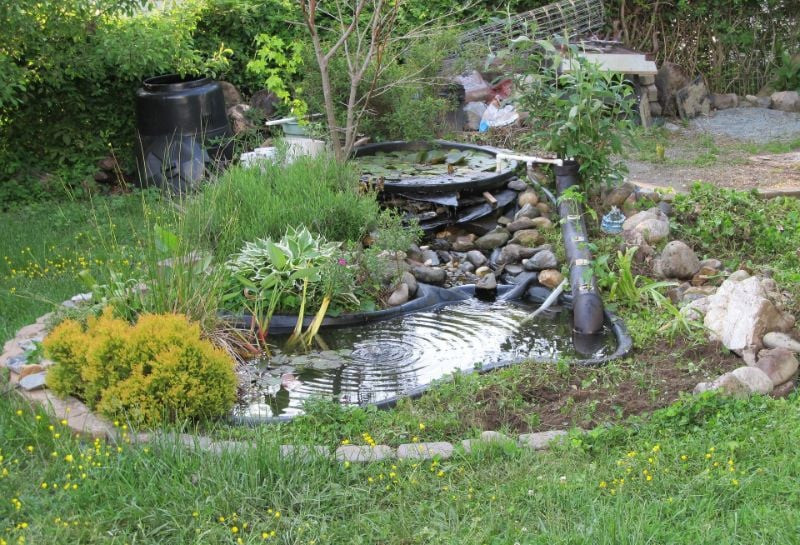 Pond with rocks and plants
Pond with rocks and plants
Alt text: A small pond is lined with rocks and surrounded by plants.
- Rock Gardens with Water: Combine rocks, alpine plants, and a small water feature to create a rock garden with a refreshing element.
- Natural Pools: Build a natural pool with rocks and gravel to create a swimming area that blends seamlessly into the landscape.
- Cascading Streams: Design a cascading stream with rocks and pebbles to create a dynamic and visually appealing water feature.
- Lighting: Add underwater lighting to highlight the rocks and create a magical ambiance at night.
- Maintenance: Plan for regular maintenance to keep the water clean and the rocks free from algae and debris.
9. Building Rock Retaining Walls
What are the steps to build a sturdy rock retaining wall? Rock retaining walls are functional and attractive features that can prevent erosion and create level areas in your landscape.
- Planning: Determine the height and length of the wall and choose the appropriate type of rock for the project.
- Excavation: Excavate the area where the wall will be built, ensuring a solid foundation.
- Base Layer: Create a base layer with gravel to provide drainage and stability.
- Rock Placement: Place the largest rocks at the bottom of the wall, gradually working your way up with smaller rocks.
- Backfilling: Backfill behind the wall with gravel and soil to provide support and drainage.
- Compaction: Compact the soil behind the wall to prevent settling and ensure stability.
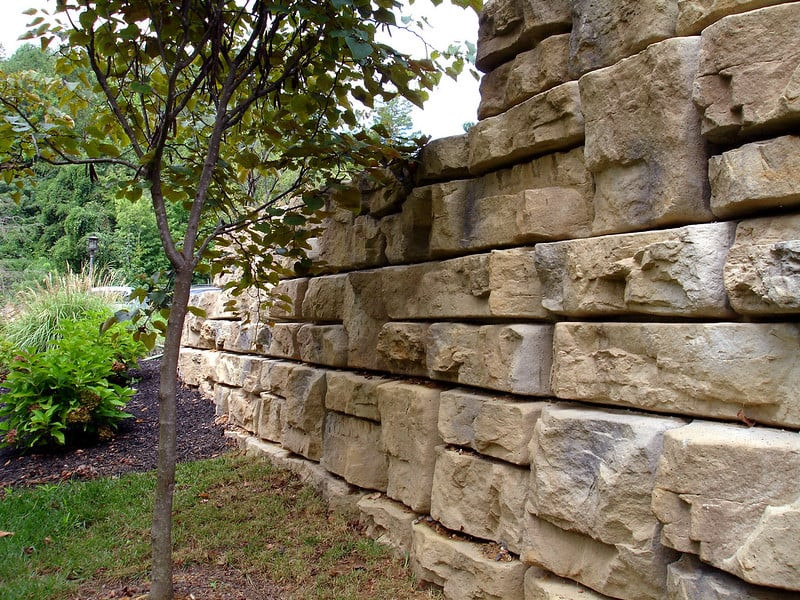 Rock Wall
Rock Wall
Alt text: A rock wall retains the soil and creates a level area.
- Drainage: Install a drainage system behind the wall to prevent water buildup and ensure longevity.
- Angle: Angle the wall slightly back into the slope to increase stability.
- Mortar: Use mortar to secure the rocks in place if desired, creating a more permanent structure.
- Safety: Follow safety guidelines and wear appropriate protective gear during the construction process.
10. Designing Rock Fire Pits
How do you design a safe and stylish rock fire pit? Rock fire pits create a cozy and inviting atmosphere in your outdoor space.
- Location: Choose a safe location away from trees, buildings, and other flammable materials.
- Base: Create a base with gravel or sand to provide a level and stable surface.
- Rock Selection: Select heat-resistant rocks, such as lava rock or fire-resistant brick, for the fire pit walls.
- Wall Construction: Build the fire pit walls with the selected rocks, ensuring they are securely in place.
- Diameter: Determine the diameter of the fire pit based on your space and desired seating capacity.
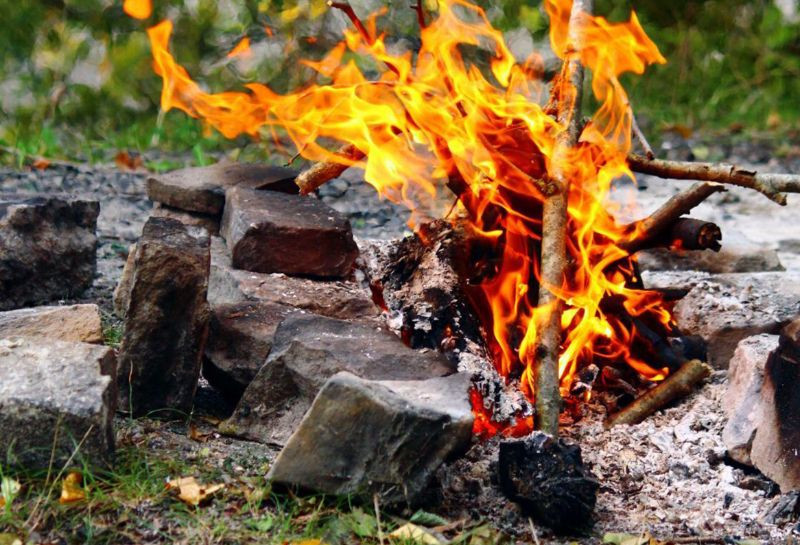 Fire pit
Fire pit
Alt text: A rustic fire pit made with natural stones.
- Ventilation: Provide adequate ventilation by leaving small gaps between the rocks in the walls.
- Liner: Consider using a metal liner to protect the rocks from heat damage.
- Seating: Add seating around the fire pit with rocks, benches, or chairs to create a comfortable gathering space.
- Safety: Keep a fire extinguisher or water source nearby and never leave the fire unattended.
- Regulations: Check local regulations and obtain any necessary permits before building a fire pit.
11. Xeriscaping with Rocks
What are the key principles of xeriscaping with rocks? Xeriscaping is a water-wise landscaping technique that utilizes rocks and drought-tolerant plants to conserve water and create a low-maintenance landscape. According to research from Arizona State University’s School of Earth and Space Exploration, xeriscaping can reduce water consumption by up to 60% in arid climates.
- Planning: Design a landscape that minimizes water usage by grouping plants with similar water needs and using rocks as mulch.
- Soil Preparation: Amend the soil with compost and other organic matter to improve its water-holding capacity.
- Plant Selection: Choose drought-tolerant plants that thrive in arid conditions, such as succulents, cacti, and native grasses.
- Rock Mulch: Use rocks as mulch to retain moisture in the soil and suppress weed growth.
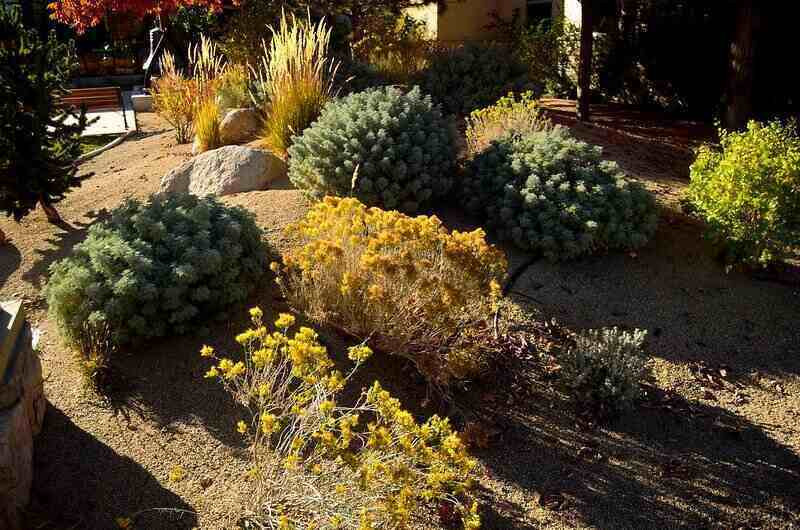 xeriscape landscaping with small bushes
xeriscape landscaping with small bushes
Alt text: Xeriscape landscaping with small drought-tolerant bushes and rocks.
- Drainage: Ensure proper drainage to prevent water buildup and root rot.
- Irrigation: Install a drip irrigation system to provide water directly to the plants, minimizing water loss through evaporation.
- Maintenance: Regularly remove weeds and prune plants to maintain a tidy and healthy landscape.
- Rock Features: Incorporate rock features, such as dry creek beds and rock gardens, to add visual interest and enhance the natural aesthetic.
- Water Harvesting: Consider implementing water harvesting techniques, such as rainwater collection, to further reduce water usage.
- Regulations: Check local regulations and obtain any necessary permits before implementing a xeriscape.
12. Enhancing Entrances with Rocks
How can you use rocks to create an inviting entrance? Rocks can be used to enhance your home’s entrance and create a welcoming first impression.
- Accent Boulders: Place large boulders near the entrance to add a dramatic and natural touch.
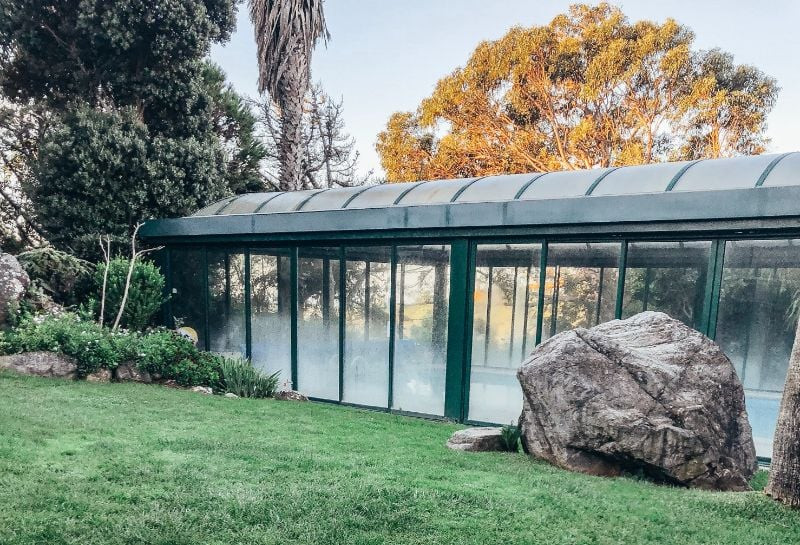 Large Boulder
Large Boulder
Alt text: A large boulder is placed near a home’s entrance.
- Rock Borders: Define the edges of the entrance pathway with rock borders to create a clear and inviting walkway.
- Stepping Stones: Use flat rocks as stepping stones to lead visitors to the front door.
- Rock Gardens: Create a small rock garden near the entrance to add visual interest and a touch of nature.
- Water Features: Incorporate a small water feature with rocks to create a soothing and welcoming atmosphere.
- Lighting: Add lighting to highlight the rocks and plants and create a magical ambiance at night.
- Plant Combinations: Combine rocks with drought-tolerant plants to create a low-maintenance and visually appealing entrance.
- Color Coordination: Choose rocks that complement the colors of the house and surrounding landscape.
- Texture Contrast: Combine rocks with different textures to create visual interest and depth.
- Signage: Use rocks to create a natural and rustic sign for your house number or address.
13. Mixing Different Rock Types
Why should you mix different rock types in your landscape? Mixing different rock types can add visual interest, texture, and depth to your landscape.
- Variety: Combine rocks with different colors, shapes, and sizes to create a dynamic and visually appealing landscape.
- Texture: Mix rocks with different textures, such as smooth river rocks and rough-hewn boulders, to add tactile interest.
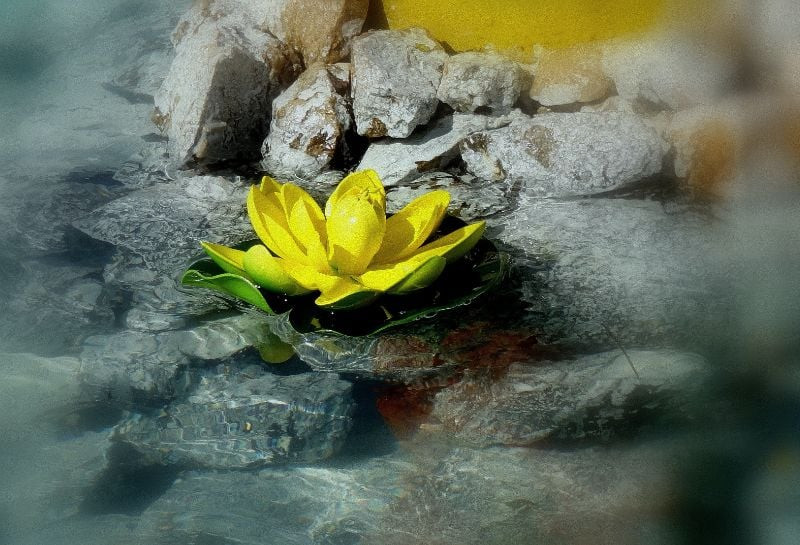 Rock garden with yellow flower
Rock garden with yellow flower
Alt text: A rock garden combines different types of rocks.
- Color: Choose rocks with different colors to create a vibrant and eye-catching landscape.
- Layering: Layer different types of rocks to create depth and dimension in the landscape.
- Focal Points: Use larger rocks as focal points and smaller rocks as accents to create a balanced and visually appealing design.
- Naturalism: Mimic natural rock formations by arranging rocks in a seemingly random and organic manner.
- Transitions: Create smooth transitions between different rock types to ensure a cohesive and harmonious landscape.
- Plant Combinations: Combine different types of rocks with various plants to create a diverse and visually appealing garden.
- Balance: Strive for balance by distributing different rock types evenly throughout the landscape.
- Experimentation: Don’t be afraid to experiment with different combinations of rocks to find what works best for your landscape.
FAQ About Adding Rocks to Your Landscape
What are the benefits of adding rocks to your yard’s landscaping?
Adding rocks boosts curb appeal, enhances drainage, reduces maintenance, controls erosion, suppresses weeds, and offers an eco-friendly, versatile, year-round, and drought-tolerant natural look.
What are some types of landscaping rocks?
Common landscaping rocks include river rock, gravel, boulders, flagstone, lava rock, decomposed granite, cobblestone, pea gravel, slate, quartzite, and fieldstone.
Where can I find landscaping rocks in the United States?
You can find landscaping rocks at garden and hardware stores or specialized landscape rock companies, or even contact construction and landscaping companies for extra rocks.
How do I choose the right size and type of rock for my landscape?
Consider the overall style, desired function, and existing landscape to select the right size and type of rock that complements the design.
How do I prepare the ground before adding rocks to my landscape?
Clear the area, grade the soil, install landscape fabric, edge the area, compact the soil, amend the soil (if necessary), install irrigation (if necessary), and consider drainage.
How do I maintain a rock landscape?
Regularly remove weeds, clean the rocks with water, and ensure proper drainage to keep the landscape tidy and healthy.
Can I use rocks to create a dry creek bed?
Yes, rocks are excellent for creating dry creek beds, which can improve drainage and add a natural element to the landscape.
How do I prevent weeds from growing in my rock landscape?
Install landscape fabric underneath the rocks and regularly remove any weeds that manage to grow through.
What are some creative ways to use rocks in my landscape?
Consider building rock gardens, retaining walls, water features, fire pits, and pathways to add unique and functional elements to your landscape.
Can I mix rocks with plants in my landscape?
Yes, mixing rocks with plants can create a balanced and visually appealing landscape, especially when combining drought-tolerant plants with rock mulch.
Transform Your Landscape with rockscapes.net
Ready to elevate your landscape with the timeless beauty and functionality of rocks? At rockscapes.net, we offer a wealth of inspiration, detailed information on various rock types, and expert tips to guide you through every step of your project. From selecting the perfect stones to mastering installation techniques, we provide the resources you need to create a stunning and sustainable outdoor space.
Don’t wait to transform your yard into a captivating rock garden, a serene water feature, or a low-maintenance xeriscape. Visit rockscapes.net today to explore our extensive collection of ideas, discover the best rock options for your specific needs, and connect with our team of professionals for personalized advice. Let us help you bring your vision to life and create a landscape that you’ll love for years to come.
Address: 1151 S Forest Ave, Tempe, AZ 85281, United States
Phone: +1 (480) 965-9011
Website: rockscapes.net